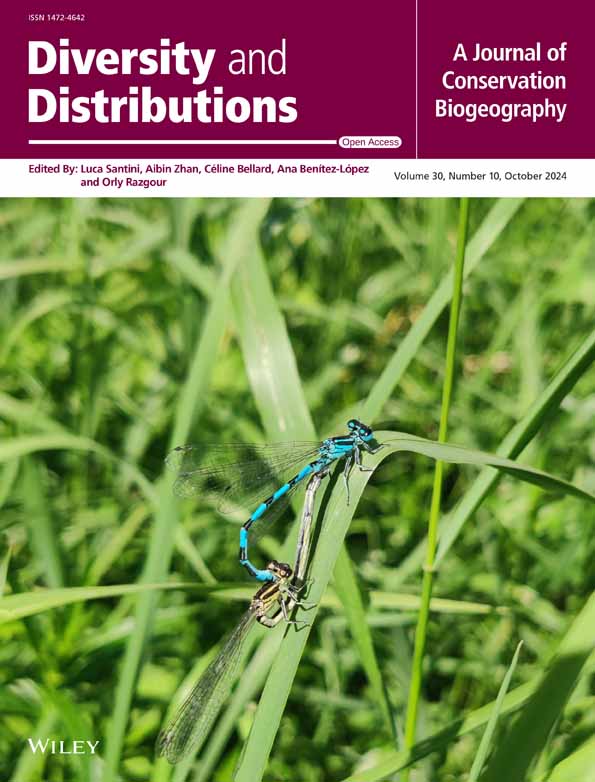Ver ítem
- xmlui.general.dspace_homeCentros e Institutos de InvestigaciónCIRN. Centro de Investigaciones de Recursos NaturalesInstituto de Recursos BiológicosArtículos científicosxmlui.ArtifactBrowser.ItemViewer.trail
- Inicio
- Centros e Institutos de Investigación
- CIRN. Centro de Investigaciones de Recursos Naturales
- Instituto de Recursos Biológicos
- Artículos científicos
- Ver ítem
Mapping opportunities and barriers for coexistence between people and pumas in the Argentine Dry Chaco
Resumen
Aim: The persistence of large carnivore populations depends on their survival outside protected areas, where they often impact local livelihoods through livestock depredation. Understanding the impacts of human behaviour on large carnivores in shared landscapes is thus important but is often overlooked in habitat assessments or conservation planning. We employed an integrated approach that considers human behaviour and landscape structure metrics to
[ver mas...]
Aim: The persistence of large carnivore populations depends on their survival outside protected areas, where they often impact local livelihoods through livestock depredation. Understanding the impacts of human behaviour on large carnivores in shared landscapes is thus important but is often overlooked in habitat assessments or conservation planning. We employed an integrated approach that considers human behaviour and landscape structure metrics to assess the potential for human-puma (Puma concolor) coexistence in the Chaco region, a global deforestation and defaunation hotspot.
Location: Argentine Dry Chaco (~490,000 km2).
Methods: We identified suitable puma habitat patches and movement areas using occupancy modelling and combined it with a spatial human-puma conflict risk model based on interview data to identify ‘safe’ and ‘unsafe’ habitat patches. We then used resistance surfaces to identify ‘safe’ and ‘unsafe’ movement areas, as well as ‘severed’ movement areas where anthropogenic land conversion inhibits movement.
Results: Safe puma habitat patches (i.e., suitable and safe) covered 29% of the region, whereas attractive sinks (i.e., suitable but risky) represented 12%. Movement areas corresponded to 60% of the region, while conflict risk and high landscape resistance undermined connectivity: unsafe and severed movement areas covered 10% and 11% of the region, respectively. Nearly 98% of safe habitat and movement areas occurred outside protected areas.
Main Conclusions: We provide an integrated conceptual framework and spatial explicit template for a three-pronged conservation strategy to (1) protect safe habitat and movement areas, (2) mitigate livestock depredation in attractive sinks and unsafe movement areas and (3) restore landscape in severed and matrix areas to improve ecological connectivity. This would allow pumas to maintain viable populations while reducing negative impacts on local people. More generally, we show how integrating habitat and conflict risk models can reveal opportunities and challenges for human-carnivore coexistence beyond protected areas.
[Cerrar]

Autor
Nanni, Ana Sofía;
Ghoddousi, Arash;
Romero Muñoz, Alfredo;
Baumann, Mathias;
Burton, Jamie;
Camino, Micaela;
Decarre, Julieta;
Martello, Felipe;
Regolin, André Luis;
Kuemmerle, Tobias;
Fuente
Diversity and Distributions 30 (10) : e13920. (October 2024)
Fecha
2024-10
Editorial
Wiley
ISSN
1366-9516
1472-4642
1472-4642
Formato
pdf
Tipo de documento
artículo
Palabras Claves
Derechos de acceso
Abierto
 Excepto donde se diga explicitamente, este item se publica bajo la siguiente descripción: Creative Commons Attribution-NonCommercial-ShareAlike 2.5 Unported (CC BY-NC-SA 2.5)
Excepto donde se diga explicitamente, este item se publica bajo la siguiente descripción: Creative Commons Attribution-NonCommercial-ShareAlike 2.5 Unported (CC BY-NC-SA 2.5)


